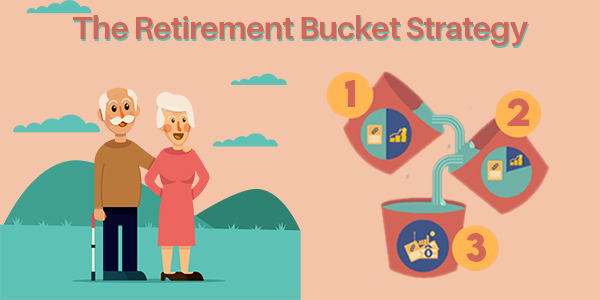You'll probably have some of your money invested in stocks to keep parts of your portfolio growing even while you live off those assets in your senior years. However, if the market falls during your retirement years, selling stocks or other assets at a loss might increase your risk of running out of money in the long run. But if you don't invest, you will fail to catch up with inflation and fall short of cash later into retirement.
This is where the bucket retirement strategy comes in. Developed by Harold Evensky in 1985, the bucket strategy divides assets into two categories or buckets. However, a later variation of the same method uses three buckets to allocate assets to avoid risks strategically.
What Is The Bucket Retirement Strategy?
The bucket plan is a method of organizing your savings holistically to address today's market difficulties while satisfying your immediate, short-term, and long-term financial needs.
“The retirement bucket strategy is a simple, but effective way to create a comprehensive plan for saving for retirement. The idea is to divide your annual income into different buckets, and then invest the money accordingly,” says Paw Vej from Financer.com Ltd. “First, there are fixed-income investments, such as bonds, that are placed in the savings bucket because they offer stability and modest returns over time. This placement may be appropriate if you plan on living off your savings for many years down the line.” These assets will increase your nest egg faster than inflation while also allowing you to replenish your immediate and intermediate buckets.
Next is the intermediate or mid-term bucket, which you can use from two to ten years after retirement to handle your cost of living. Money in the middle bucket should continue to grow. Avoid investments in high-risk assets, such as certificates of deposit and bonds.
Finally, there is the immediate or short-term bucket, which is easily accessible cash you may need at any given moment, so rather than investing, this money should be kept in bank accounts, short-term CDs, or high-yield savings accounts.
On the other hand, the two-bucket strategy involves the cash bucket and the investment bucket. You don't want to withdraw from investments when the market is down; it can hurt you in the long run.
So having a savings bucket can cover you for up to five years, and it can protect your expenses while you wait for the market to recover, and you don’t have to go for easy access to payday loans or any form of debt. The investment bucket will make your money future-proof and let it grow, and when the market is not down, you can use its returns to replenish your savings bucket.
What Types Of Investments Should Be Put Into Buckets And Why?
According to mortgage expert Alan Harder, “short-term investments should be relatively safe and liquid, so you can access them quickly if needed. Examples include savings accounts, money market funds, and short-term bonds.”
“Medium-term investments can be a little riskier, but should still offer liquidity and stability. Examples include bond funds, balanced mutual funds, and target date funds,” says Alan.
Your goal with the last bucket would be to invest in a diversified portfolio of stocks and related assets. It should be split between domestic and international investments, ranging from small-cap to large-cap stocks. Long-term bucket investments are made in riskier assets that may be volatile in the short term but have long-term growth potential.
Pros And Cons Of The Bucket Strategy
Benefits of the bucket strategy
- “The main benefit of the bucket strategy is the sense of comfort and assuredness that it provides. Knowing that your immediate financial needs are taken care of may allow you to feel better about investing boldly in your other buckets,” says Anthony Martin from Choice Mutual.
- A bucket strategy will protect you from sequence risk, i.e., the danger of the timing of withdrawals from a retirement account damaging your overall return. This risk is avoided by investing in fixed-income assets, which provide a consistent return. Furthermore, withdrawals are made only from the cash bucket, while the other two buckets are only used to replenish the cash bucket.
- The bucket plan also makes the retirement income setup cleaner and visible to you. You can have an accurate idea of how much you have in each bucket and how much the specific assets are growing; this way, you won't be blind-sighted by a financial crisis, or you won't have to worry about the condition of the market and inflation.
- This strategy also protects you from longevity risk; you will not run out of cash during your lifetime as the short-term bucket will be filled up by the other two buckets any time it runs out due to a financial crisis. No matter how long you live after retirement, your assets in the third bucket will keep growing. You can enjoy a comfortable retirement without having to worry about medical bills, changing your lifestyle, or reducing your expenses.
Downsides of the bucket strategy
- If you have low-risk tolerance, it may not be for you because the short-term bucket will not grow much over time; riskier investments are required in one or two buckets for this strategy to work.
- A significant disadvantage of many bucket approaches is determining how to rebalance the investment portfolio or refill the short and medium-term buckets over time. For example, if you frequently empty the near-term bucket and have to sell your long-term assets to replenish it, you are essentially just using your long-term assets.
- Joe Troyer from Digital Triggers points out, “the main drawback of the retirement bucket strategy is that it's not very flexible. Once you've divided your savings into three buckets, it can be difficult to change your mind. You may have to pay taxes and penalties if you need to access the money in your long-term bucket.”
Are There Any Better Alternatives?
The bucket retirement strategy allows you to take risks without worrying about the near future expenses because short-term investments are typically held in cash or other liquid securities; a market downturn may only affect long-term "buckets" that you may be less concerned about due to the long time horizon until they require distributions. This psychological advantage can save large sums of money by preventing panic-driven decisions.
But there are other strategies available if you think the bucket method may not suit your retirement needs. The flooring strategy prioritizes secure retirement income over a more volatile, riskier investment portfolio. You would work with a financial planner to set aside a "floor" amount of money to cover mandatory annual expenses during their retirement years. To cover non-essential costs, you can add riskier securities and investments to their portfolio.
The systematic Withdrawal Approach involves investing across a wide range of asset classes and withdrawing a proportionate amount each month. So, it treats all of a client's assets the same way, deducting the required income from the total. The fully diversified portfolio is rebalanced regularly to account for these regular withdrawals over time. There is only one asset allocation target to maintain, and annual withdrawals are predictable at 4% to 5%.
According to Cliff Auerswald from All Reverse Mortgage, “another strategy to consider is the target date fund. This can provide you with the necessary assets to cover your retirement expenses based on when you plan to retire. For example, if you plan to retire in 2035, a target date fund would aim to have the majority of its assets in stocks, as they offer the potential for higher returns over the long term. As you get closer to retirement, the fund will gradually shift more into bonds and other fixed-income investments, which are less volatile and provide income during retirement.”
The Bottom Line
The retirement bucket strategy is a way to make sure your money will last through retirement by putting it in different buckets. The buckets include short-term, intermediate-term, and long-term investments. Each one has a different goal. With the "bucket strategy" for retirement, there are a number of pros and cons to think about. There are definitely better alternatives out there; the best option for you depends on your financial goals and situation. There are a number of potential benefits and drawbacks to the retirement bucket strategy to consider.









